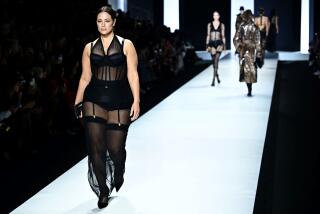A Renewed Esprit, Aiming for the Old Spirit
- Share via
SAN FRANCISCO — Heather Colmar of Newport Beach had one important mission to accomplish during her school break this summer: get to Esprit de Corp’s Bay Area outlet store.
“It’s very popular where I live,” said Heather, a 17-year-old high school senior, clutching a bag containing $86 worth of Esprit wear. “It’s cute and I like the style.”
Executives of Esprit, a brand that was once the envy of the fashion industry, today live for such customer affirmation as they work to polish a company image tarnished over the last six years by management power struggles, fashion flops and financial woes. Having lost market share to competitors such as Gap Inc., J. Crew and Guess Inc., Esprit is making a major push to reclaim its former powerhouse position in junior and young women’s apparel.
This summer, the company that made a name for itself in the 1970s and early ‘80s with innovative design and retail strategies opened the first of 14 stores it will add this year, including one in Old Town Pasadena and another in the Beverly Center in Los Angeles. Negotiations are underway to open a store on Santa Monica’s Third Street Promenade next year. The company, which started the year with just three U.S. retail stores and 23 outlets, down from a total of 80 at its peak, plans to add 40 retail stores over the next few years.
By opening stores again, Esprit hopes to reestablish what had been a close connection with customers, as well as showcase updated clothing and accessory designs.
The company is also beefing up its presence in Macy’s, Bloomingdale’s and other department stores with in-store mini-shops. Esprit has also resurrected its popular catalog. The colorful oversized publication featuring customers and employees modeling Esprit clothes was last produced a decade ago, but the company said it still gets as many as 100 catalog requests a week. The new catalog, designed by Los Angeles-based Hershey Group and due out in October, is expected to introduce a new generation to Esprit as well as show previous customers that the company is back.
Esprit also is boosting its ad budget by two-thirds, to $5 million.
Despite its struggles, the company incorporated in 1970 by Doug and Susie Tompkins still has plenty of cachet to draw on in making a comeback, Chairman and Chief Executive Jay Margolis said.
“The statement I got constantly was: ‘Oh, Esprit, that’s a great company. What do they do now?’ ” said Margolis, a 20-year industry veteran who took the reins of a demoralized Esprit in January of last year. “Yes, we needed to fix the infrastructure and systems and warehousing, but more than anything we had to build credibility with the consumer.”
Esprit, he said, is through running after trends. Having done some homework studying old Esprit designs and talking to former and potential customers, company executives are positioning Esprit to appeal to women ages 17 to 30. Esprit, company management is fond of saying, is “an attitude and not an age.”
In its new fall collection, the company pays sharper attention to detail, uses better-quality fabrics and aims for the kind of versatile young-but-sophisticated look that helped set Esprit apart in its early days. Prices range from $48 to $68 for sweaters, $88 to $118 for lined wool jackets and $48 to $68 for matte crepe jersey skirts and pants.
“I think there is a void between the Gap and Banana Republic,” Margolis said. “We’re more contemporary than the Gap and younger than where Banana has gone.”
Los Angeles retail consultant Sandy Potter of Directives West said the changes under Margolis are evident.
“What I saw was terrific,” she said. “They are definitely back on track.”
Analysts said Esprit has a solid foundation on which to build and that the company has found a strong manager in Margolis, who they said did well both as president of Tommy Hilfiger U.S.A. Inc. and as vice chairman of Liz Claiborne Inc.
“They have the experience in department stores, the know-how in free-standing stores; they just have to execute better,” said Arnold Aronson, a former chief executive of Bullock’s and Saks Fifth Avenue now in charge of retail strategy at Kurtz Salmon Associates in New York.
Margolis--an equity partner since October, when Esprit’s domestic operations were acquired by creditors Oaktree Capital Management of Los Angeles and New York’s Cerberus Partners--said he’s working to tighten general operations. The warehousing division, for example, was moved from San Francisco, where the company still has its headquarters, to Los Angeles, where larger facilities allow for more efficient garment storage.
“We’re running the business smarter, our inventories are in line, we don’t have a lot of excess markdowns that are costing a lot of money,” Margolis said.
For the first time in years, he said, Esprit is turning a profit and employees are being given shares of company stock as an incentive. The privately held company does not disclose its profits but said U.S. sales, which had been falling since hitting a peak of $400 million in 1990, are slowly rebounding. Sales this year are expected to reach $300 million from about $250 million last year. That has helped Esprit reverse the big losses it suffered in 1993 and 1994, the company said.
For Esprit executives, the improving bottom line is welcome evidence that the company is on the right track again.
As they candidly assessed Esprit’s past missteps, Margolis and Esprit’s design director for the last 10 years, Marcus Brown, agreed in a recent interview that the company became distracted and lost its way in the late ‘80s and early ‘90s amid the personal upheavals of the Tompkinses, who eventually divorced and have since sold their interests in Esprit.
“The quality had fallen apart, there was not the same value from a production point of view, the design aesthetic was inconsistent,” said Margolis, the company’s fourth CEO since 1991. Brown added that “Doug and Susie together had a strong vision and balanced each other well, but with each controlling [Esprit] at different stages, we kind of went off on different tangents.”
In 1991 and 1992, Esprit tried Ecollection, a line of clothing made in all-natural fabrics, and a line designed to appeal to over-25 women, but neither took off. Most recently, Esprit went after the younger teenage market, churning out inexpensive copycat clothing. But the company found it couldn’t distinguish itself from the competition. The result, said Alan Millstein, editor and publisher of the industry newsletter Fashion Network in New York, was that “the Gap and Limited/Express has eaten their lunch.”
Under Margolis, Esprit is making some headway in its battle to recapture its position in fashion’s front lines. U.S. department store managers report stronger sales for Esprit clothing and accessories, which has led to the chains’ granting more floor space to Esprit’s line this year.
The Macy’s stores at the Glendale Galleria and South Coast Plaza are among the Southern California sites where the larger Esprit sections will be a centerpiece of the junior apparel sections. The in-store mini-shops are 1,500 to 3,500 square feet and feature concrete floors, industrial-style fixtures, dramatic lighting and music and video screens. Macy’s in San Francisco and New York are also in line for a much bigger Esprit presence.
“Esprit has a powerful name,” said Bill Moll, senior vice president and women’s wear merchandising manager at Macy’s West, which has seen double-digit increases in Esprit sales. “The truth will tell in the long term, but we feel good about the direction,” he said.
Bloomingdale’s, too, is expanding Esprit displays in the stores that carry junior clothing.
“Wherever we’ve had the line, it’s been one of the best-selling brands,” said Frank Doroff, executive vice president of Bloomingdale’s, which, like Macy’s, is a unit of Federated Department Stores Inc.
Esprit is now carried in 1,000 U.S. department stores and specialty stores. The company, which has 90 of the larger in-store mini-shops, will add 50 more this year as well as upgrade existing displays. Margolis sees the in-store shops as key to Esprit’s future.
A growing number of Nordstrom stores are also picking up the line, and Robinsons-May carries Esprit accessories. In other parts of the U.S., Dillard’s, Yonkers and Federated’s Burdine’s carry Esprit clothes.
In some ways, Esprit seems more focused on competing with its former self than with other clothing manufacturers. As the company retools for a new generation, Margolis continually finds himself turning to the customer-driven business model upon which Esprit was founded.
“It’s still a challenge for us every day to get back to what Esprit is, to fine-tune that,” Margolis said. “We’re still being taught every day by the consumer, because ultimately that’s who’s going to dictate where the company goes. If I brought anything to the company, it’s that our egos are not what it’s all about.”






